Watch and Wait, or Do Something?
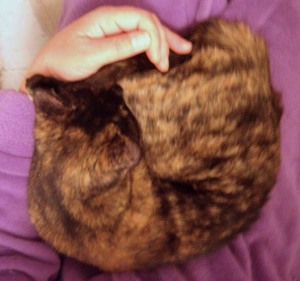
It’s 3:00 a.m. and though I’m finally ready to go to bed I can see that Kelly is feeling no better, in fact she is even more lethargic than she was earlier. It may be just my middle-of-the-night all-alone-with-my-fears worry, but where I was earlier ready to just observe until morning I’m considering my options.
I take her temperature, and now it’s 103.9, just getting to the danger zone. Earlier it was 102.5, not too far from normal and an increase that may have been just from stress and only something to note and check later, but this needs to be dealt with now. Kelly has been confined in the bathroom all day for observation, and everything I need is here.
Why does this always happen right in the middle of the “dead zone” of overnight when it’s too late to call anyone, and it’s hours until I can reasonably contact anyone in the morning? At least it will be Monday morning and I will have more options than on the weekend.
Why am I the only fool awake in the middle of the night? Part of the issue with decision-making in cases like these is trusting my own judgement—is it serious enough to run off to emergency or should I just wait? Am I equipped to do something here? If I didn’t go, would I regret it later if Kelly was worse and I should have gotten her treatment at 3:00 a.m. instead of 9:00 a.m.? Why can’t it be morning? I really wish I had someone to talk it over with.
I write this for those of you who often find yourselves in the same situation, sitting alone in the middle of the night watching a cat who’s not giving you any clues as to what’s wrong, while you try to decide what to do about it.
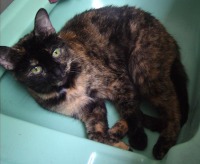
And don’t worry, Kelly and Peaches are fine, so is everyone else.
After years of middle-of-the night quandaries, I have two ideas that work together. I’ve actually come to believe that in the quiet of the dark hours without the distractions of the day our mind can simply focus more clearly and observation and decision-making are much easier. I don’t like staying up late, but I can focus on my work at a level I sometimes require, and I’ve made some of my best decisions which seemed insurmountable during the day, in these hours.
So, first, the lack of distractions makes unusual things more apparent; you may not notice an unusually quiet kitty during the day, but when there is nothing to distract you all senses are aware of the situation. You can assess and decide quickly.
Second, the body has natural rhythms, and even we humans with a simple cold will feel worse in the middle of the night. Of course your pet will as well. And perhaps because of those natural rhythms it seems that we sometimes lose ground in fighting an illness overnight, as if our bodies, exhausted from the effort, give a little to the darkness.
In the daytime, I’d immediately call my veterinarian. In the middle of the night, I call up all she’s taught me, and all my similar experiences, and let the clarity of these quiet hours help focus my thoughts.
What would a veterinarian do for a fever without other obvious symptoms…begin antibiotics and administer fluids before anything else. I can do that, and then see what happens.
I start getting things together and flip on the bathroom light, which stabs my tired eyes; I usually only have a small table lamp on in the bathroom at night to give my eyes a rest, but I need to see what I’m doing. Yes, I can take a cat’s temperature in dim light, especially when someone donated a really nice digital LED thermometer to me, no I can’t count out antibiotics or give fluids.
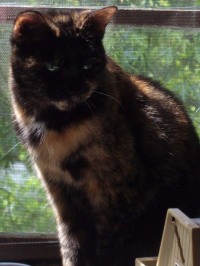
I have my choice of three antibiotics on hand, amoxicillin powder, clavamox pills and Baytril pills, but I know that Baytril is the most effective of the three when a fever is present, so I drip a dropper of water into Kelly’s dry little mouth, pop a half of a 22.5 mg in next and follow with a little more water to help it go down. Kelly’s confused, but feeling too ill to put up a big fight. Mostly she talks.
I have subcutaneous fluids on hand for Peaches, but even without a cat in renal failure I usually have a fresh bag, a fluid line and needles handy; it keeps the evil spirits away (long story). I had given Kelly about 50cc of fluids earlier in the day just to help her out after a difficult morning, but that’s not a therapeutic dose and it was hours ago. Now was time for a real dose.
I warm the fluids in some hot water in the sink and get Kelly ready on my lap, talking gently, stroking her, letting her settle herself. She complains but again doesn’t put up too much of a fight as I push the needle through her skin and feel the fluids begin to flow through the line and under her skin, and I try to relax.
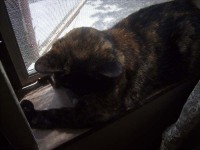
Whenever I give a cat fluids I always imagine the feel of the needle pushing through the skin and how the fluids must feel as they fill in the loose flap under a cat’s scruff. I’ve often wondered if that was an image I was visualizing through my cat in this intimate physical contact of a somewhat invasive treatment. Later, when I donate blood, the same image comes back as they push the needle into my vein and I flinch even though I’ve donated gallons and it doesn’t really hurt.
All this goes through my mind during the four or five minutes it takes to let 150 cc flow and I look up to watch the fluids coursing into the fluid line, look down to see Kelly shuffling a little and hear her talk. When it’s done I roll the shutoff on the line and slide the needle from her skin, holding my finger over the spot and massaging to help the skin close again. I’m a far cry from the first few times I did this…probably 15 or more years ago. I’m glad I learned. It may be all she needs. If it’s not, I’ve gotten things started hours earlier than otherwise.

Kelly begins to resettle herself into the lap of my purple fleece robe as I remain where I was sitting on the toilet lid. I decide to sit with her for a while and just observe, so I reach up and turn out the light, leaving only the soothing glow of the table lamp and the radio playing something by Chopin that I should know but can’t name at the moment. I don’t have a clock in the bathroom (that works) and I have no idea how long I’ve been working with Kelly, or how long I’ll sit here. Until I know something, I guess.
This began, well, yesterday morning. Kelly was out of sorts with no interest in breakfast and seeming a little uncomfortable. I fed everyone, Peaches her special canned food, then went back to Kelly.
She has a little bit of a hard time now that Namir is gone, since the Big Four have joined the house with Mimi, and Dickie gets in the way. Kelly is very active and vocal and friendly, but very submissive to other cats and if someone is sitting near the water bowl, she won’t drink. I have six water bowls around the house, but Kelly doesn’t go in some of those areas. She also waits until no one is around to use the litterbox, either in the basement or the bathroom, but if someone is in the way, she waits. With nine cats, this can literally be all day sometimes.

In this way, she has gotten herself rather dehydrated and constipated a few times in the past year and that may simply be the problem. She has also gone the other direction with frequent diarrhea, actually being diagnosed with inflammatory bowel disease. In between these two extremes she’s fine. I take her up to the bathroom and close the door and she immediately hops in the box and has normal movements on both accounts. I praise her and sit with her for a little bit knowing if this is the cause, then she’s been a little traumatized by the other cats even if they haven’t looked in her direction. A little time out may be in order.
Normally, she’ll eat now. Back downstairs, I offer her breakfast, but she has no interest. I try to tempt her with some other favorites like a few drops of milk and plain yogurt, and she acts interested but does not partake.
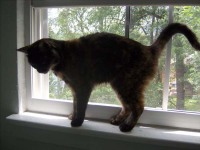
Observation begins. It is Sunday and I have a day of outdoor activities away from home. Kelly is not improving. Back to the bathroom, otherwise known as the kitty sick room. Take her temperature the first time, give her 50cc of fluids to see if it helps, leave her there all day, and though she seems to rally through the evening, here I am at about 4:00 a.m., still thinking things over as Kelly relaxes little by little.
I’ve had other unknown viruses move through my household over the years, and while some have caused high fevers and lethargy, everyone recovered. I never knew where they had come from. My cats don’t go outside, and no one new had come in. In each case I was the only contact. The day before, I had been at the Waynesburg Sheep & Fiber Fest meandering among farm animals and various animals’ sheared pelts. Had I carried something home on my clothing or skin?
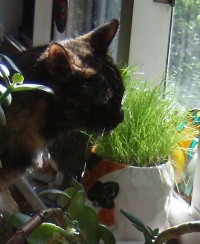
But, in those dark hours I was also remembering our recently lost friend Amber. Ingrid King had kept us posted as Amber had begun with puzzling but non-specific symptoms, and we later learned it was a feline calicivirus. That was a little too recent for my comfort. I also remembered other friends who had suddenly lost cats to similar viral infections. Was I doing the right thing in keeping Kelly at home and just starting fluids and antibiotics? In the light of what I knew, should I run her off to emergency to see if anything else was out of sorts that I couldn’t find? I’m not a veterinarian, nor a veterinary technician, I have no formal training, I only know what I’ve learned through experience and what I take in intuitively. If Kelly’s life was at stake, didn’t she deserve a more learned opinion?
Kelly has adjusted herself slightly now and then until she is curled into her happy ball with her head turned upside down and all her long legs tangled, purring lightly. That is, actually, a good sign. A comfortable cat is not one feeling the aches and pains of a fever, nor potential gastric upset. I quietly take her temperature. It’s down to 103.3. I think I’ll try to get some sleep instead of running off with her. Tomorrow may be a long day. When I cross the landing to my bedroom it is ten minutes to 5:00 a.m.
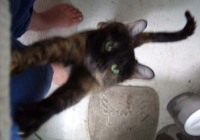
Kelly is cheerful in the morning, but still not eating. I call my vet on Monday to tell her the condition and order more Baytril. She agreed this seemed viral, so she decided seven days if Kelly cleared up quickly enough, or we’d play it by ear and go longer, continuing the fluids as long as she wasn’t eating and adding Pepcid in case of an upset stomach. I briefly recounted the story of Amber so she’d know what was on my mind.

It was Tuesday breakfast before Kelly was tentatively eating baby food off of a spoon, but her fever was gone and she improved through the week. Thursday I let her back out and she was feeling quite fine.

Over the weekend, Peaches began to vomit and became seriously dehydrated. Big doses of fluids every day, Pepcid and special food. She was feeling much better by Wednesday, but when I fed Peaches her last meal of the day in the kitchen before I went to bed, Kelly vomited several times, nothing big, only seeming as if she had a hairball and was gagging. Hairballs don’t happen too often, and when she was done she jumped up and wanted to eat with Peaches. No big deal, I thought, just remember that it happened. But again I remembered Amber.
The next morning, still vomiting a few times, Kelly ended up back in the bathroom, no fever, messy stool, dose of fluids but eating by dinner time and feeling better the next day.
So my veterinarian and I are watching for other symptoms just in case…well, just in case, maybe, something is going through the house. Peaches’ immune system is compromised by her renal failure though she’s handled everything quite well so far. If Kelly does have an inflammatory bowel issue then her immune system is compromised as well, or it could just be that she’s highly stressed by the situation.
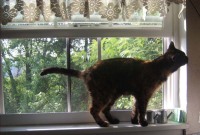
In either case, Peaches is sleeping on her little Dora the Explorer couch in my office, and Kelly is feeling well and eating well and actually enjoying herself in the sunny bathroom without worrying about other cats, though she’s beginning to want out.
But I feel as if I’m waiting for something to happen. Was the second round, for Kelly, a continuation of her original virus? Did Peaches catch a strain of it? Is it something different or is it completely unrelated? Is it anything at all, just Kelly’s reaction to her circumstances and Peaches battling renal failure? I may never figure this out. But I’ll keep looking for clues.
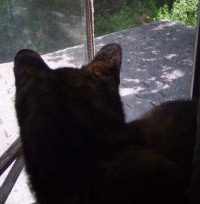
So, how much time do we spend observing our cats for…whatever? How often do you follow your cat to the litterbox? Do you clean up any vomit and study it for clues? Do you catch yourself running to the grocery store in the middle of the night for anything that might perk up their appetite, even though you never feed them anything like that otherwise?
I don’t mind all the time spent observing and caring for them, because I form a tighter bond with them, and I learn something new that I can use later with another cat and perhaps share with a friend. I just wish that, if they had to get sick, they’d do it at a more opportune time so I didn’t limit my already limited sleep schedule any further.


Oh, Bernadette
I am so sorry you are all going through this. It seems that all of us, cats, humans, dogs, get worse at night. It may be a biological thing, I don’t know. But it really happens.
My cat Crosby had his forst asthma attack at night, and at 4 a.m. he was in such a bad shape that I had to run to the hospital in the middle of a snow storm. It was one of the scariest moments in my life. I wrote about it here: http://www.thedailytail.com/nonfiction/asthma/
I’ll pray for you all. Be well, my dear.
Oh Bernadette, my heart goes out to you. Those dark hours in the middle of the night are the worst. It’s hard to get past the fear and arrive at the stillness of the moment that allows us to make the “right” decisions.
I’ve always felt the way you do – a little bit of fluid therapy is always a good start when a cat is not feeling well, and I always had fluids on hand for that purpose. After Buckley and Amber, I don’t feel that way anymore. As you know from reading my book, Buckley was given subcutaneous fluids when she was feeling so sick – and they pushed her into congestive heart failure, because she already had some mild heart disease, and the extra fluid load was more than her heart could handle. And then, the same thing happened with Amber. The supportive care that seemed indicated for her viral condition – fluids and steroids – pushed her into congestive heart failure. We had no idea she had an underlying heart condition. She got a well-kitty check up every six months, and her vet never heard anything when she listened to her heart that would even remotely suggest that something was wrong. As a result, I will never allow fluids to be given to a cat of mine without an echocardiogram. Yes, I may be overly cautious now, but it showed me that even “routine” therapies are never routine. Each cat, and each body, is different.
I’m not suggesting that your choice for Kelly was wrong – it clearly helped her feel better. And obviously, with Peaches, fluids are most definitely indicated. The only reason I’m sharing my experience is so your readers can understand that fluid therapy can sometimes be the wrong choice.
I’m not an advocate of randomly starting antibiotic therapy, but it sounds that you made the right choice, since your vet agreed with you. The problem with randomly choosing an antibiotic is that different antibiotics cover different spectrums of bacteria, and without knowing what you’re treating, you can do more harm than good, especially in an already compromised immune system. In my opinion, too many vets still reach for Clavamox or Baytril without running bacterial cultures first.
And yet, even having said all that, sometimes, it just comes down to honoring our “gut feeling,” listening to our intuition, and doing what we think is right for each individual cat. Medicine only goes so far.
Ingrid,
I agree completely about these two common therapies, and after reading your experiences about Amber, both those in the moment and afterward from both you and Dr. Crist, I seriously considered this treatment before I took action on it, and I’ll never take it for granted anymore. That was why I had begun with the conservative 50cc dose for Kelly earlier in the day. If it had only been her constipation issue, the 50cc is something she’s tolerated in the past, and 50cc is a dose many cats can tolerate in most conditions.
In addition to his HCM and CHF, Namir also had idiopathic cystitis apparently caused by a herpes virus in his bladder that would flare up every few months. He never had a crystal or stone and the pH was completely normal, but he would really suffer from the pain and swelling and sometimes his urine had so much blood it was terrifying; I kept him on cranberry and vitamin C, and the condition wasn’t so frequent or so bad. He already had a noted arhythmia and no one wanted to anesthetize and catheterize him unless they had to, and phenoxybenzamine, the compound medication to relax the urinary sphincter, just made him pass out. The one thing that worked was abut 150cc of fluids to flush his system, but after the onset of his CHF this would have killed him, though we learned he could tolerate 50cc. So this became the base dose for me when I would give fluids to a cat who had never had fluids before.
In Kelly’s case, it was the rising fever that made me decide on both the fluids and the antibiotics, and Baytril in particular. With a moderate or steady fever, I wouldn’t have done either one, and I know that you can let a spiking fever ride its course without treatment, but it’s not always wise to do. Kelly had tolerated up to 150cc within the past year with no ill effects at all, and my veterinarian and I had discussed 100cc as a treatment for her when she began showing symptoms because it was likely from her social causes. I didn’t hear anything upper respiratory and she seemed to swallow fine, and amoxi and Clavamox seem to work best on respiratory issues and infections from wounds. Baytril is most often the one used for viral infections.
Still, it’s always taking a chance, especially with Kelly, who is 16. Staying awake to observe is the other important part of the treatment, watching and listening to her breathing and checking to see if her body relaxed or she continued to act uncomfortable, and this time, in light of your experience with Amber, I was glad I actually knew the symptoms of congestive heart failure in case that was an issue. I had my stethescope handy if I saw any breathing difficulty, and she only seemed to respond positively.
And it is partly just that gut feeling. Sometimes Kelly just needs a time out, and it would be entirely wrong to start giving her stuff when she’s just overburdened by navigating her way among the other cats.
It’s also important to point out to others how complicated animal health care is, and especially for cats. I think we need to keep relaying our experiences so others can learn from them.
Thanks for reading!
Bernadette
Oh, I do hope your kitties get thru all this mess and are feeling better soon!
BZ